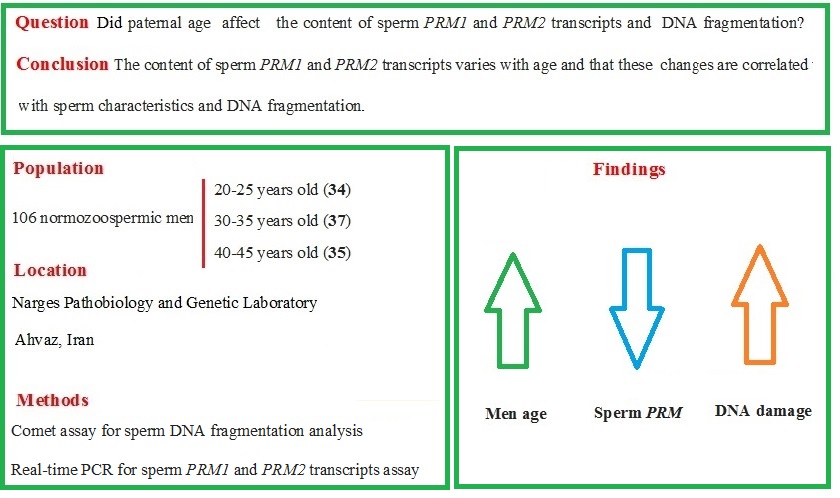Wed, Oct 8, 2025
[Archive]
Volume 23, Issue 6 (June 2025)
IJRM 2025, 23(6): 507-516 |
Back to browse issues page
Ethics code: 93.12.20.180
Download citation:
BibTeX | RIS | EndNote | Medlars | ProCite | Reference Manager | RefWorks
Send citation to:



BibTeX | RIS | EndNote | Medlars | ProCite | Reference Manager | RefWorks
Send citation to:
Dolatshahi B, Dorostghoal M, Galehdari H, Hemadi M. Association of sperm protamine1 and protamine2 transcript content with paternal age: A cross-sectional study. IJRM 2025; 23 (6) :507-516
URL: http://ijrm.ir/article-1-3502-en.html
URL: http://ijrm.ir/article-1-3502-en.html
1- Department of Biology, Faculty of Science, Shahid Chamran University of Ahvaz, Ahvaz, Iran.
2- Department of Biology, Faculty of Science, Shahid Chamran University of Ahvaz, Ahvaz, Iran. & Biotechnology and Bioscience Research Center, Shahid Chamran University of Ahvaz, Ahvaz, Iran. ,dorostghoal@gmail.com
3- Fertility, Infertility and Perinatology Research Center, Ahvaz Jundishapur University of Medical Sciences, Ahvaz, Iran.
2- Department of Biology, Faculty of Science, Shahid Chamran University of Ahvaz, Ahvaz, Iran. & Biotechnology and Bioscience Research Center, Shahid Chamran University of Ahvaz, Ahvaz, Iran. ,
3- Fertility, Infertility and Perinatology Research Center, Ahvaz Jundishapur University of Medical Sciences, Ahvaz, Iran.
Abstract: (203 Views)
Background: Over the last decade, there has been a significant increase in average paternal age.
Objective: The present study investigated the effects of male age on sperm parameters, DNA fragmentation, and protamine1 (PRM1) and protamine2 (PRM2) transcript content in normozoospermic men.
Materials and Methods: In this cross-sectional study, 106 semen samples from normozoospermic men were obtained. The objects were divided into 3 age groups: 20-25, 30-35, and 40-45 yr. Sperm parameters and DNA fragmentation were assessed, and transcript levels of PRM1 and PRM2 were analyzed in ejaculated spermatozoa.
Results: The highest levels of sperm concentration, motility, and normal morphology were observed in men aged between 20 and 25 yr. Significant declines were seen in sperm total motility (p = 0.006) and normal morphology (p = 0.015) after 40 yr compared to younger men. Significantly (p < 0.001) higher levels of DNA damage were seen in 40-45-yr-old men. DNA fragmentation correlated significantly with sperm total motility (r = -0.242, p = 0.012) and normal morphology (r = -0.257, p = 0.008). The lowest levels of PRM1 and PRM2 transcripts were seen in 40-45-yr-old men. DNA damage was significantly associated with reduced transcript levels of PRM1 (r = -0.453, p = 0.018) and PRM2 (r = -0.492, p = 0.009). Transcript levels of PRM1 and PRM2 in ejaculated spermatozoa were correlated significantly with the age of men.
Conclusion: Our findings demonstrate age-related changes in sperm PRM1 and PRM2 transcript content and their correlations with sperm parameters and DNA fragmentation.
Objective: The present study investigated the effects of male age on sperm parameters, DNA fragmentation, and protamine1 (PRM1) and protamine2 (PRM2) transcript content in normozoospermic men.
Materials and Methods: In this cross-sectional study, 106 semen samples from normozoospermic men were obtained. The objects were divided into 3 age groups: 20-25, 30-35, and 40-45 yr. Sperm parameters and DNA fragmentation were assessed, and transcript levels of PRM1 and PRM2 were analyzed in ejaculated spermatozoa.
Results: The highest levels of sperm concentration, motility, and normal morphology were observed in men aged between 20 and 25 yr. Significant declines were seen in sperm total motility (p = 0.006) and normal morphology (p = 0.015) after 40 yr compared to younger men. Significantly (p < 0.001) higher levels of DNA damage were seen in 40-45-yr-old men. DNA fragmentation correlated significantly with sperm total motility (r = -0.242, p = 0.012) and normal morphology (r = -0.257, p = 0.008). The lowest levels of PRM1 and PRM2 transcripts were seen in 40-45-yr-old men. DNA damage was significantly associated with reduced transcript levels of PRM1 (r = -0.453, p = 0.018) and PRM2 (r = -0.492, p = 0.009). Transcript levels of PRM1 and PRM2 in ejaculated spermatozoa were correlated significantly with the age of men.
Conclusion: Our findings demonstrate age-related changes in sperm PRM1 and PRM2 transcript content and their correlations with sperm parameters and DNA fragmentation.
Type of Study: Original Article |
Subject:
Reproductive Genetics
Send email to the article author
| Rights and permissions | |
 |
This work is licensed under a Creative Commons Attribution-NonCommercial 4.0 International License. |








